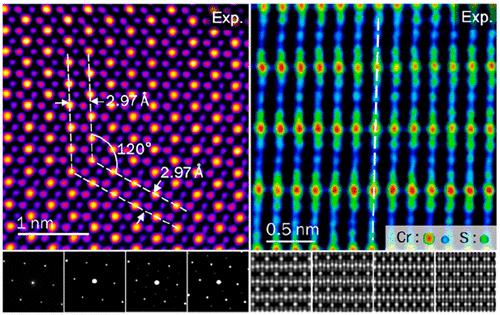当前位置:
X-MOL 学术
›
Nano Lett.
›
论文详情
Our official English website, www.x-mol.net, welcomes your
feedback! (Note: you will need to create a separate account there.)
Atomic Imaging and Thermally Induced Dynamic Structural Evolution of Two-Dimensional Cr2S3
Nano Letters ( IF 9.6 ) Pub Date : 2022-09-21 , DOI: 10.1021/acs.nanolett.2c02974 Chia-Ling Liu, Yi-Tang Tseng, Chun-Wei Huang, Hung-Yang Lo, An-Yuan Hou, Che-Hung Wang, Akira Yasuhara, Wen-Wei Wu
Nano Letters ( IF 9.6 ) Pub Date : 2022-09-21 , DOI: 10.1021/acs.nanolett.2c02974 Chia-Ling Liu, Yi-Tang Tseng, Chun-Wei Huang, Hung-Yang Lo, An-Yuan Hou, Che-Hung Wang, Akira Yasuhara, Wen-Wei Wu

|
In this study, facile salt-assisted chemical vapor deposition (CVD) was used to synthesize ultrathin non-van der Waals chromium sulfide (Cr2S3) with a thickness of ∼1.9 nm. The structural transformation of as-grown Cr2S3 was studied using advanced in situ heating techniques combined with transmission electron microscopy (TEM). Two-dimensional (2D) and quasi-one-dimensional (1D) samples were fabricated to investigate the connection between specific planes and the dynamic behavior of the structural variation. The rearrangement of atoms during the phase transition was driven by the loss of sulfur atoms at elevated temperatures, resulting in increased free energy. A decrease in the ratio of the (001) plane led to an overall increase in surface energy, thus lowering the critical phase transition temperature. Our study provides detailed insight into the mechanism of structural transformation and the critical factors governing transition temperature, thus paving the way for future studies on intriguing Cr–S compounds.
中文翻译:

二维 Cr2S3 的原子成像和热诱导动态结构演化
在本研究中,采用简易盐辅助化学气相沉积 (CVD) 方法合成厚度约为 1.9 nm 的超薄非范德华硫化铬 (Cr 2 S 3 )。采用先进的原位技术研究了生长后的 Cr 2 S 3的结构转变加热技术与透射电子显微镜 (TEM) 相结合。制作二维 (2D) 和准一维 (1D) 样品以研究特定平面之间的联系和结构变化的动态行为。相变过程中原子的重排是由高温下硫原子的损失驱动的,导致自由能增加。(001)面比例的降低导致表面能的整体增加,从而降低了临界相变温度。我们的研究提供了对结构转变机制和控制转变温度的关键因素的详细见解,从而为未来研究有趣的 Cr-S 化合物铺平了道路。
更新日期:2022-09-21
中文翻译:

二维 Cr2S3 的原子成像和热诱导动态结构演化
在本研究中,采用简易盐辅助化学气相沉积 (CVD) 方法合成厚度约为 1.9 nm 的超薄非范德华硫化铬 (Cr 2 S 3 )。采用先进的原位技术研究了生长后的 Cr 2 S 3的结构转变加热技术与透射电子显微镜 (TEM) 相结合。制作二维 (2D) 和准一维 (1D) 样品以研究特定平面之间的联系和结构变化的动态行为。相变过程中原子的重排是由高温下硫原子的损失驱动的,导致自由能增加。(001)面比例的降低导致表面能的整体增加,从而降低了临界相变温度。我们的研究提供了对结构转变机制和控制转变温度的关键因素的详细见解,从而为未来研究有趣的 Cr-S 化合物铺平了道路。


















































 京公网安备 11010802027423号
京公网安备 11010802027423号